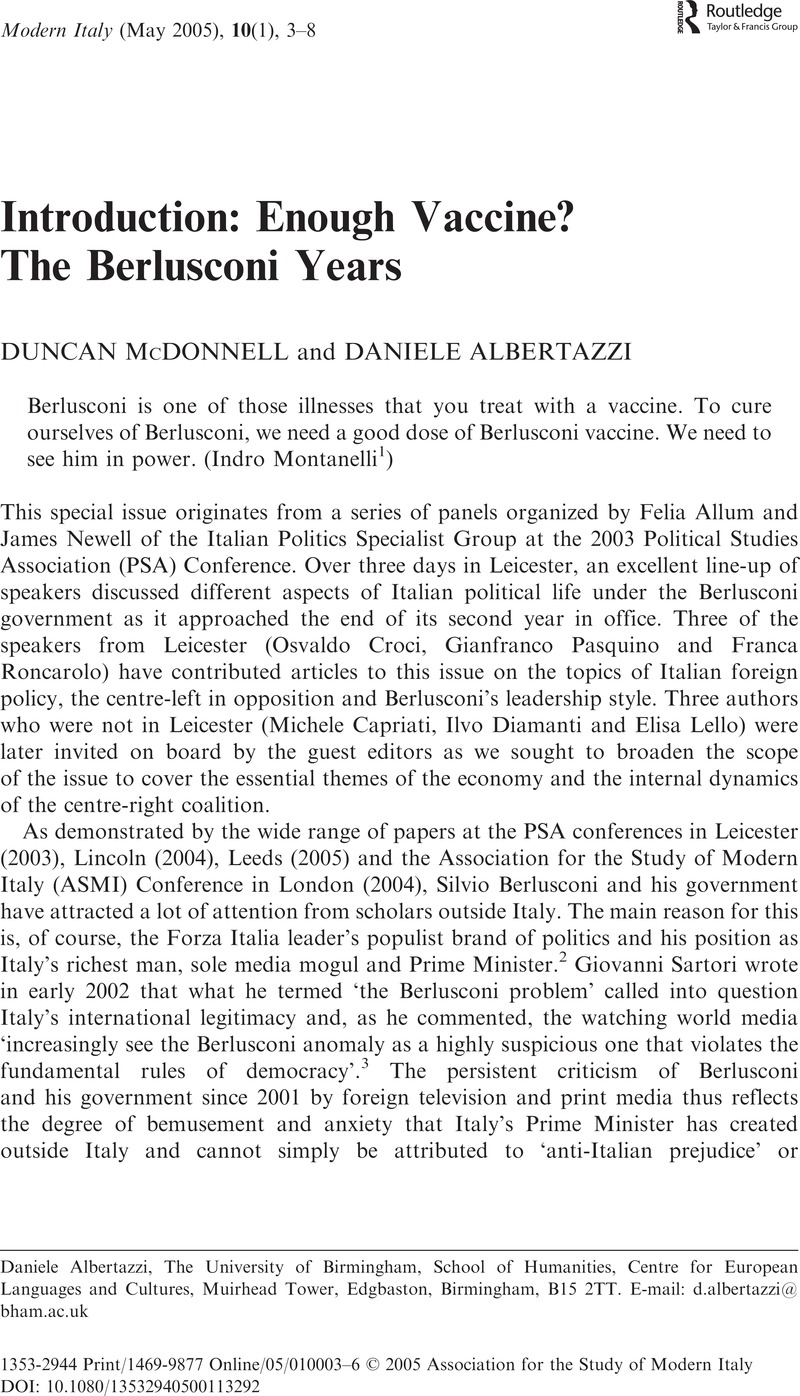Article contents
Introduction: Enough Vaccine? The Berlusconi Years
Published online by Cambridge University Press: 07 January 2016
Abstract

- Type
- Introduction
- Information
- Copyright
- Copyright © Association for the study of Modern Italy
References
Notes
1. Interview with Montanelli, Indro on Enzo Biagi's Il fatto , 27 March 2001.Google Scholar
2. See Tarchi, Marco, L'Italia populista, dal qualunquismo ai girotondi , Il Mulino, Bologna, 2003; Ginsborg, Paul, Berlusconi: ambizioni patrimoniali in una democrazia mediatica, Einaudi, Turin, 2003.Google Scholar
3. Sartori, Giovanni, ‘Conflitto d'interessi’, in Tuccari, Francesco (ed.), Il governo Berlusconi: le parole, i fatti, i rischi , Laterza, Rome, 2002, pp. 21–33, p. 31.Google Scholar
4. See for instance ‘Fit to Run Italy?’, The Economist , 26 April 2001; ‘Unfit to Lead Europe’, The Economist, 8 May 2003; ‘Doubts Cloud Berlusconi EU Debut’, http://news.bbc.co.uk, 1 July 2003; ‘Citizen Berlusconi’, Le Monde, 13 March 2004.Google Scholar
5. The Foreign Minister, Ruggiero, Renato, resigned on 6 January 2002 following a very public dispute over the European Union and EMU with cabinet colleagues. Two days before Ruggiero's resignation, the Minister for Reform, Bossi, Umberto, had referred to Ruggiero in an interview as an insignificant bureaucrat. See ‘Bossi: Ruggiero è un burocrate con un'attrazione fatale per la sinistra. Non l'ha eletto il popolo, per me non conta’, Corriere della Sera , 4 January 2002. Scajola, Claudio was forced to resign as Home Affairs Minister on 3 July 2002 after apparently telling journalists that the government consultant Biagi, Marco (murdered on 19 March 2002 by a group claiming to be the Red Brigades) had been ‘a ballbreaker (rompicoglioni) who wanted his consultancy contract renewed’. See ‘Scorta negata a Biagi, lo sfogo di Scajola’, Corriere della Sera, 30 June 2002. Giulio Tremonti was forced to resign as Finance Minister on 3 July 2004 following severe pressure on Berlusconi from, in particular, the leader of AN, Gianfranco Fini. See, for example, ‘E Fini avverte il Cavaliere: Giulio cambi o vada via’, La Repubblica, 17 June 2004 and ‘Tremonti minaccia: Lascio ma il premier resta freddo’, La Repubblica, 2 July 2004.Google Scholar
6. Fuelled by stories of Bossi, Berlusconi and Tremonti, meeting regularly for Monday evening dinners, the CDL was said to be divided into two main groups: a ‘Northern axis’ consisting of the three pro-business, ‘new politicians’ from Lombardy and the so-called ‘subgovernment’ made up of the traditionally ‘pro-South’ and ‘pro-public sector’ professional politicians of AN and the UDC.Google Scholar
7. See ‘Slippery Silvio’, The Economist , 16 December 2004.Google Scholar
8. Boeri, Tito and Garibaldi, Pietro, ‘Un paese in mezzo al guado’, http://www.lavoce.info, 4 September 2002.Google Scholar
9. Three months after 11 September 2001, the deputy Finance Minister Tanzi, Vito famously declared that he could already detect signs of economic recovery in the country. Contrary to Tanzi's view, the 2003 ISTAT Annual Report said that the Italian economy had been characterized by ‘stagnation’ throughout the whole of 2002 and 2003. On the widespread fears that the national economy might fail to recover in the near future, see the ‘Considerazioni generali’ of the Rapporto Censis 2004, http://www.censis.it Google Scholar
10. On 2 July 2003, at the opening of Italy's Presidency of the European Union in the European Parliament, Berlusconi reacted to questions from the German MEP, Schulz, Martin, by telling him that he would be perfect for the role of Kapò (prison guard) in a Nazi camp. The look of despair on the face of Fini, Gianfranco spoke volumes. On 6 November 2003, during a press conference with Putin, Vladimir at an EU–Russia meeting in Rome, Berlusconi defended Russia's actions in Chechnya. This provoked indignation across Europe and strong criticism from both the Commission and the European Parliament.Google Scholar
11. Ginsborg, Paul, Berlusconi: Ambizioni , p. 67.Google Scholar
12. Bellucci, Paolo and Bull, Martin, ‘Introduction: The Return of Berlusconi’, in Bellucci, Paolo and Bull, Martin (eds), Italian Politics: A Review , 17, Berghahn, New York, 2002, pp. 29–47, p. 38.CrossRefGoogle Scholar
13. A brief and convincing explanation of this thesis can be found in Bordignon, Massimo, ‘Il circolo vizioso dei condoni’, http://www.lavoce.info, 20 January 2004.Google Scholar
14. The Bossi–Fini law and the resultant sanatoria (amnesty) were cases in point. See Colombo, Asher and Sciortino, Giuseppe, ‘La legge Bossi-Fini: estremismi gridati, moderazioni implicite e frutti avvelenati’ in Blondel, Jean and Segatti, Paolo (eds), Politica in Italia 2003, Il Mulino, Bologna, 2003, pp. 195–215. The mainly symbolic importance of this law is also demonstrated by the fact that it is impossible to enforce, see Boeri, Tito, ‘Bossi-Fini: quando il tagliando non basta’, http://www.lavoce.info, 2 September 2004.Google Scholar
15. See Prodi's speech, http://www.dsonline.it Google Scholar
16. Ginsborg, Paul, Italy and Its Discontents , Penguin, London, 2001, p. 292.Google Scholar
17. See ITANES, Perché ha vinto il centro-destra , Il Mulino, Bologna, 2001.Google Scholar
18. Diamanti, Ilvo, Bianco, rosso, verde…e azzurro, mappe e colori dell'Italia politica , Il Mulino, Bologna, 2003, chapter 4; Sartori, Giovanni, Homo Videns, Laterza, Bari, 1997.Google Scholar
19. Berlusconi signed the Contratto con gli Italiani live on the television programme Porta a Porta on 8 May 2001, see http://www.forza-italia.it/silvioberlusconi/contratto.htm Google Scholar
20. The storia italiana referred to here was a glossy and hagiographical public relations pamphlet celebrating Silvio Berlusconi's life, sent to every Italian household in the run-up to the 2001 election.Google Scholar
- 2
- Cited by




